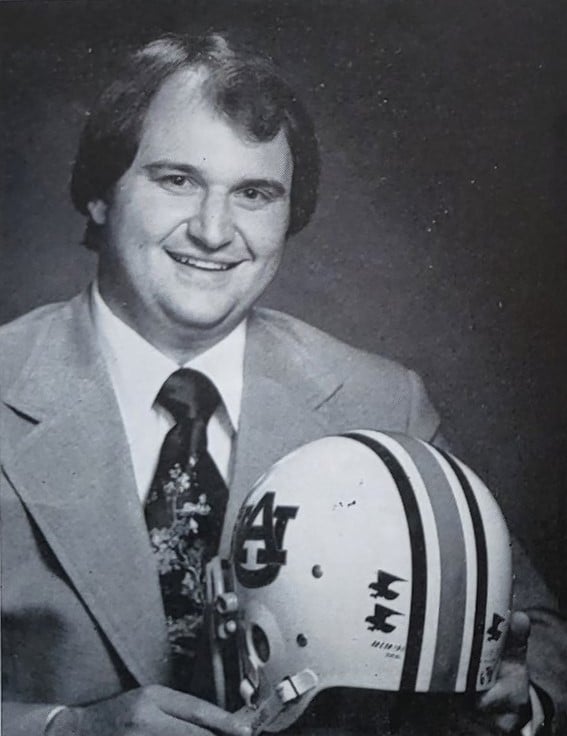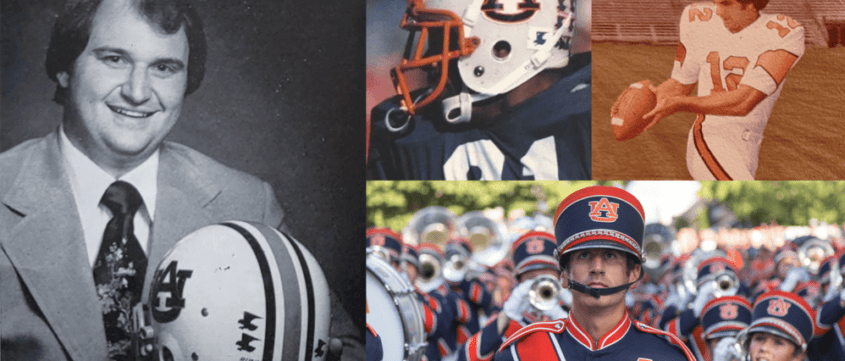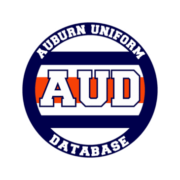Randy Brown – The Auburn Designer You Didn’t Know
Randy Brown loves the Auburn-Opelika area. It’s all he’s known, in fact.
“I’ve lived in six places and none of them were more than a few miles from where I’m currently sitting,” he said with a hearty chuckle.
After graduating from Opelika High School, Randy carried in his family’s footsteps and attended the local university. His father played in the Auburn University Marching Band during the late 1940s.
“My whole family went to Auburn.”
Randy studied art while at Auburn and also joined the band. With experience from his job working at National Screenprinters at the corner of Dean Road and Opelika Parkway, Randy would often create decals to place on the band’s bass drums. The earliest drum decal featured an eagle carrying a drum placed underneath a large block A.
As a sophomore in 1974, Band Director Billy Walls approached Randy about producing a new logo for the AUMB. Randy and fellow band-mate June Holland tag-teamed the project and came away with the all-familiar Eagle-A design that was used by the program until 2017.
In 2018, the AUMB ordered new uniforms that removed the Eagle-A design from the left chest of the jackets. Word is that the University wanted to create a more comprehensive branding across the board, and thus the band-specific logo was replaced with the traditional AU logo.
When asked about the replacement, Randy confidently stated, “It had to happen. It always should’ve been the AU.”
No hard feelings from Randy’s perspective.
In 1976, Randy was preparing to write the thesis for his art degree. The choice was simple – redesign the Auburn Football uniforms.
The project started with a new primary logo. At this point, the now-traditional AU logo had only donned the helmets for a decade. Randy wanted to implement more “eagle” into the design. He designed a new “double eagle” logo, a rather blocky silhouette of a flying eagle with the tail-end of the design replicating the head of the eagle.
It’s like many of the “hidden images” in designs like the FedEx logo. Once you see it, you’ll never unsee it.
As a student, Randy became good friends with Phil Gargis. Phil played quarterback for Shug Jordan and then Doug Barfield.
When Doug Barfield was hired as Shug’s successor, Phil brought his friend Randy to meet the new head coach. Walking through the door, Randy was carrying his work-in-progress thesis project to show Barfield.

A proud Randy Brown with the 1976 Auburn helmet featuring his eagle design on the back (image via 1976 Auburn Football Illustrated program)
Barfield immediately took to the eagle design. The Auburn coaching staff wanted to implement a decal-reward system for the Tigers similar to what is used at Ohio State. And Randy’s design was the perfect match.
“The staff set up the criteria for earning a decal and it just happened that the eagle Randy designed was perfect for what we were looking for,” Barfield stated in the 1976 season opener program. The eagle design also donned program covers for many years to come.
Randy left the meeting with Coach Barfield and went to his job at National Screenprinter. There, he produced a few hundred decals for Barfield to use for his team.
The original decals were printed on a clear piece of vinyl, as most decals were. But the material didn’t last long. Randy then pivoted to printing the eagle logo on a white background. Even with the Tigers wearing white helmets, it was easy to spot the large white background on the decals and see how they were placed like bricks on the shells.
“You can see the two decals clearly here,” Randy said holding a 1976 football helmet with a large eagle on the sides and the Barfield pride stickers on the back. “This helmet has clearly faded since then,” Randy laughed. (You can learn more about Randy’s eagle design here.)
The helmet was produced to accompany Randy’s thesis. But so were a set of uniforms. With his own two hands, Randy created a blue, orange, and white jersey with his mother’s sewing machine.
Instead of the traditional Northwestern Stripes around the sleeves, Randy wrapped his new eagle design in its place.
“Like the classic Seattle Seahawks jersey?” I asked.
“Yep, just like that but many years prior,” Randy replied. (Seattle wouldn’t wear the wrap-around logo stripes until 1983,)
Randy and Phil Gargis, along with their third roommate Chris Vacarella, went to Jordan-Hare Stadium to show off the new threads. Staff photographer Les King, known for his iconic posing shots of players, joined in to photograph everything.

Phil Gargis (#11) and Chris Vacarella (#12) pose with Randy Brown’s thesis concept uniforms. (images via Randy Brown)
That was nearly a half-century ago and Randy still has those custom-made jerseys. “They’re in a box somewhere,” he laughed.
But the design portfolio doesn’t stop there. Randy went on to produce the Auburn Letterman’s Club logo and the 100 Years of Auburn Football logo for the program’s anniversary in 1992. Randy’s son George recalls his first memories of walking into Jordan-Hare Stadium were to help his father paint the centennial logo at midfield.
Even as a student, Randy took one job that would leave a decades-long impact on the Auburn community. Hired by George Johnston of the famous J&M Bookstore in downtown Auburn, Randy was tasked with repainting the traditional War Eagle wall that sat next to the bookstore.
The wall had been painted since the 1960s with various designs. But in 1978, Randy was paid $285 to paint a new version. And that same design, the one with the stacked Clarendon font “War Eagle” in blue with an orange drop shadow, is still used today.
Even after someone painted “Cam” between the two words during the 2010 season and construction took out the “Go Tigers” portion of the wall, the recognizable photo spot has remained ultimately the same for decades.
When Terry Bowden came to the Plains in 1993 following Pat Dye’s retirement, the new head coach ushered in a new “AUtitude” mantra into the fanbase.
After the undefeated 11-0 season in which fans wore buttons and placed bumper stickers on the cars with the Auburn-ized spelling of the word, Bowden wanted to expand his newfound brand. Randy was asked to create what was called the Bowden Attitude Collection. The primary logo featured Bowden hunched over in his familiar sideline pose.
Arguably Randy’s most successful venture came shortly after. With a suggestion from a friend, Randy produced a miniature replica of Samford Hall. There was clearly a market for these historic replicas, so The Memory Company (originally Collegiate Collectables) was born. Randy would sketch out and even carve prototype designs before flying to factories in East Asia to bring the products to life.
Clearly proud of his work, Randy continued to showcase item after item. Some were of Santa decked out in Auburn gear or Aubie donning the Prayer in Jordan-Hare angel outfit worn during the 2013 season.
But most of the items were incredibly detailed replications of Auburn landmarks. From Toomer’s Corner to Langdon Hall, the Sani-Freeze ice cream parlor, and even the Chapel that has sat at the corner of College and Thach since 1851, the collection of miniature Auburn architecture was vast and meticulously designed. The Memory Company would also produce landmark replicas for other universities across the country, including Alabama, Georgia, Florida, Georgia Tech, Harvard, and many more.
Today, Randy continues to live in the Auburn-Opelika area with his wife and enjoys spending time with his eight grandchildren. He hasn’t put the art supplies down though, continuing to dream up new developments for the community he has lived in since his birth.
Enjoy learning about Auburn uniforms and history? Want to see more like this? Be sure to follow the Auburn Uniform Database on Facebook, Instagram, and Twitter for even more uniform news. You can also purchase your favorite team’s merchandise through Fanatics, with a portion of your sale going to support this website.





This is a spit in the ocean of what RB has done. One of the most talented men I’ve ever met and I’m no slouch. -ML